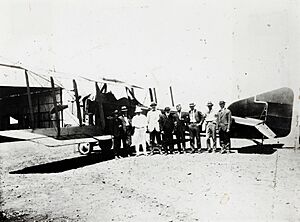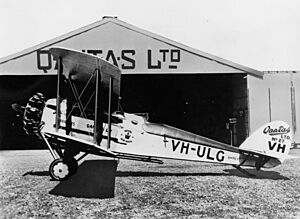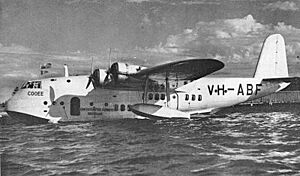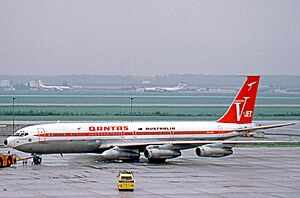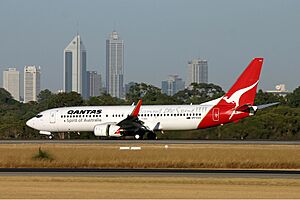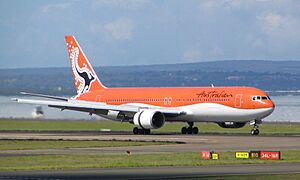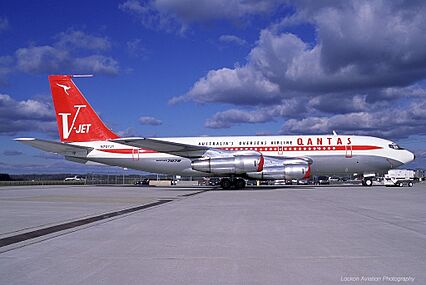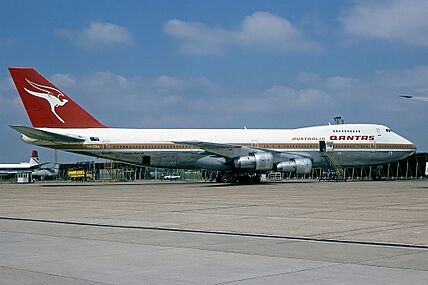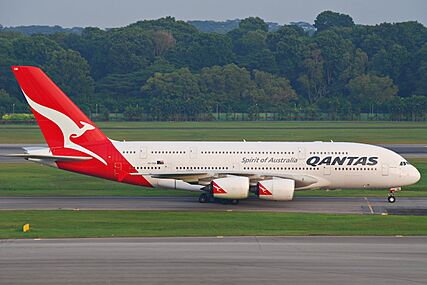History of Qantas facts for kids
Qantas is Australia's biggest airline. It started in Winton, Queensland, on November 16, 1920. Its full name was Queensland and Northern Territory Aerial Services Limited. It was founded by Paul McGinness, Sir Hudson Fysh, and Sir Fergus McMaster. Arthur Baird was their main aircraft engineer. McGinness later left, but Hudson Fysh stayed and became the chairman.
At first, Qantas offered short flights for fun and airmail services. These mail services were supported by the Australian government and connected towns in western Queensland. Between 1926 and 1928, Qantas even built some of its own planes in Longreach, Queensland. They also made the first flight for the Royal Flying Doctor Service of Australia, starting from Cloncurry, Queensland.
In 1934, Qantas teamed up with Britain's Imperial Airways to form Qantas Empire Airways Limited (QEA). They began flying internationally in May 1935, extending their service from Darwin to Singapore. World War II caused big problems for air travel until 1943. In 1947, the Australian government bought QEA, making it a national airline. That same year, Qantas started using Lockheed L-749 Constellation planes for flights to London. In 1958, Qantas became only the second airline in the world to fly all the way around the globe, using Super Constellations.
In 1956, Qantas ordered the Boeing 707 jetliner, and the first one arrived in June 1959. Qantas's first jet flight was on July 29, 1959, from Sydney to San Francisco. On September 5, 1959, Qantas became the third airline to fly jets across the North Atlantic Ocean. In 1966, the airline opened the Wentworth Hotel in Sydney. In 1967, Qantas ordered the much larger Boeing 747 and changed its name to Qantas Airways. When Cyclone Tracy hit Darwin in 1974, a Qantas Boeing 747 set a world record by evacuating 673 people on one flight! In March 1979, Qantas stopped flying the Boeing 707. Until 1985, it was the only major airline in the world to use only one type of plane (the Boeing 747).
The Boeing 747 fleet got an upgrade starting in 1989 with the new Boeing 747-400 series. The first 747-400 delivery flight set a world record for commercial aircraft, flying 18,001 km (11,185 mi) non-stop from London to Sydney. In August 1992, the Australian Government sold the domestic airline Australian Airlines to Qantas. This was the first time Qantas could fly within Australia. Qantas was sold to private owners in two steps: 25% to British Airways in 1993, and the rest to the public in 1995. In 2000, Qantas ordered twelve Airbus A380s and was the third airline to receive them. After Virgin Blue expanded in 2001, Qantas started a new, cheaper airline called Jetstar Airways. On December 13, 2004, the first Jetstar Asia flight took off from Singapore to Hong Kong, bringing Qantas into the low-cost Asian market.
Before October 29, 2011, Qantas had many international flights to and from airports like Singapore Changi, Auckland Airport, Brisbane Airport, Los Angeles International, and London Heathrow. Qantas has been one of the most successful airlines in the world. In 2008, the first Qantas Airbus A380 was delivered. Its first route was from Melbourne to Los Angeles.
Contents
History of Qantas
Early Days: 1920 to 1934
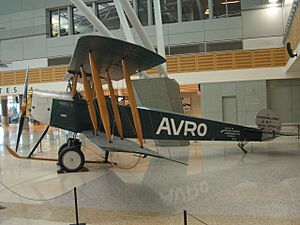
Qantas started in Winton, Queensland, on November 16, 1920. It was called Queensland and Northern Territory Aerial Services Limited. The founders were Paul McGinness and Hudson Fysh. Fergus McMaster joined as chairman, and Arthur Baird handled plane repairs. McGinness left in 1922, but Hudson Fysh stayed and became the General Manager. He retired in 1966 as Sir Hudson Fysh.
The airline's first plane was an Avro 504K, bought for about £1425. It could fly at 105 kilometres per hour (65 mph) and carried one pilot and two passengers. On November 2, 1922, an 84-year-old pioneer named Alexander Kennedy became the first passenger on a regular Qantas flight. He flew from Longreach to Cloncurry. Qantas also delivered mail, supported by the Australian government, connecting towns in western Queensland.
From 1926 to 1928, Qantas built seven de Havilland DH.50s and one DH.9 plane in its hangar in Longreach. In 1928, a Qantas plane made the very first flight for the Royal Flying Doctor Service of Australia, taking off from Cloncurry.
Flying Boats and War: 1934 to 1945

In 1934, QANTAS Limited and Britain's Imperial Airways (which later became British Airways) created a new company called Qantas Empire Airways Limited (QEA). Each company owned 49% of the new airline. QEA started flying in December 1934, connecting Brisbane and Darwin.
QEA began international flights in May 1935, extending service from Darwin to Singapore using newer planes. Imperial Airways then flew passengers the rest of the way to London. In July 1938, this service changed to flying boats, using Short S.23 Empire planes. The trip from Sydney to Southampton took nine days, with passengers staying in hotels overnight. This service was very successful until World War II. After Italy joined the war in June 1940, the route changed to the Horseshoe Route between Sydney and Durban in South Africa. This route was very important for communication between Australia and the United Kingdom until Singapore fell in February 1942. Half of Qantas's ten flying boats were lost due to enemy action or accidents.
Flying boat services started again on July 10, 1943, using American-built Consolidated PBY Catalinas. These flights went between Swan River near Perth and Koggala lake in Ceylon (now Sri Lanka). This service was called "The Double Sunrise" because the sun rose twice during the long flight. It connected with flights to London, keeping important communication lines open. This 5,652 km non-stop flight was the longest ever at that time, taking about 28 hours. Passengers even got a special certificate for flying on it!
In 1944, Consolidated B-24 Liberator planes joined the Catalinas. Later, Avro Lancastrians were used. These planes flew from Sydney to Gawler, then to Learmonth, and across the ocean to Ratmalana (in Sri Lanka). From there, other crews took over for the flight to the UK. This service was renamed the Kangaroo Service, and the famous Kangaroo logo was first used on this route.
After the War: 1945 to 1959
In 1947, the Australian government, led by Prime Minister Ben Chifley, bought QEA. This made Qantas a national airline, which was common for airlines at that time. After the buyout, the original QANTAS Limited company was closed.
Soon after becoming a national airline, QEA started flights outside the British Empire, to Tokyo via Darwin and Manila. These planes also flew between Sydney and London with BOAC. In 1949, flights to Hong Kong began.
In 1947, Qantas received Lockheed L-749 Constellation planes, which took over the main route to London. Flying boats returned to the fleet in 1950. These Short Sandringham planes flew from Rose Bay in Sydney Harbour to places like New Caledonia, Fiji, and New Guinea.
In 1952, Qantas expanded flights across the Indian Ocean to Johannesburg, South Africa. This route was called the Wallaby Route. Around this time, the British Government wanted Qantas to buy the de Havilland Comet jet, but Hudson Fysh thought it wasn't a good idea, and he was right. In early 1954, Qantas expanded across the Pacific Ocean to Vancouver, Canada, taking over the Southern Cross Route. The first of Qantas's Lockheed 1049 Super Constellations arrived in early 1954.
In January 1958, Qantas became the second airline in the world to fly all the way around the globe. They used Super Constellations, flying west from Australia to London on the Kangaroo route, and east to London on the Southern Cross route.
In September 1956, Qantas ordered the Boeing 707 jetliner. The first one was delivered in June 1959. This made Qantas the first airline outside the US to order this type of jet.
The Jet Age: 1959 to 1992
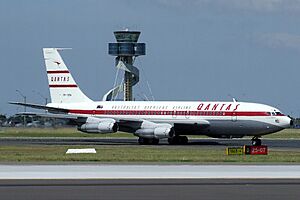
The first jet plane registered in Australia was named City of Canberra. This plane returned to Australia in 2006 to be displayed at the Qantas Founders Outback Museum in Longreach, Queensland. The Boeing 707-138 was a special, shorter version of the Boeing 707 that only Qantas ordered. Qantas's first jet flight was on July 29, 1959, from Sydney to San Francisco. On September 5, 1959, Qantas became the third airline to fly jets across the North Atlantic. All of Qantas's early jets were updated with new engines in 1961 and were called V-Jets.
Air travel grew a lot in the early 1960s, so Qantas ordered larger Boeing 707-338C planes. In 1966, Qantas opened the 450-room Wentworth Hotel in Sydney. Also in 1966, the Fiesta route opened, flying from Sydney to London through places like Fiji and Mexico City. In September 1965, Qantas started its first V-Jet service on the Kangaroo Route through Kuala Lumpur, Malaysia.
In 1967, the airline ordered the Boeing 747. This huge plane could carry up to 350 passengers, a big improvement over the Boeing 707. Orders were placed for four planes, with deliveries starting in 1971. Also in 1967, Qantas Empire Airways changed its name to Qantas Airways, which is still its name today.
When Cyclone Tracy destroyed Darwin at Christmas 1974, Qantas set a world record. They evacuated 673 people on one Boeing 747 flight! In March 1979, Qantas flew its last Boeing 707 flight. After this, Qantas became the only major airline in the world to have a fleet made up of only one type of plane (the Boeing 747). That same year, Qantas was the first airline in the world to introduce Business class.
In 1985, the Boeing 767-200 was introduced for flights to New Zealand, Asia, and the Pacific. The same year, the Boeing 747-300, with a larger upper deck, was also introduced. The Boeing 747 fleet was upgraded again starting in 1989 with the new Boeing 747-400 series. The first 747-400 delivery flight set a world record for commercial aircraft, flying 17,850 km (11,091 mi) non-stop from London to Sydney.
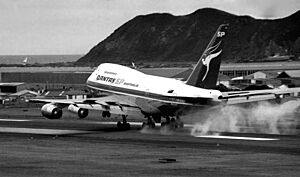
In 1990, Qantas created Australia Asia Airlines to fly to Taiwan. This airline stopped flying in 1996.
Becoming a Private Company: 1992 to 2006
The Australian Government sold the domestic airline Australian Airlines to Qantas in August 1992. This meant Qantas could now fly within Australia for the first time. Qantas was then sold to private owners in March 1993, with British Airways buying 25% of the airline. The rest of Qantas shares were sold to the public in 1995. By law, Qantas must be at least 51% owned by Australians.
In 1998, Qantas helped start the Oneworld airline alliance with American Airlines, British Airways, and others. This alliance began in February 1999. Oneworld helps airlines offer more destinations and work together to save money.
In 2000, Qantas ordered twelve Airbus A380s, the world's largest passenger plane. Qantas was the third airline to receive these planes, after Singapore Airlines and Emirates.
Qantas's main domestic competitor, Ansett Australia, stopped flying on September 14, 2001. This meant Qantas suddenly had almost 90% of the market. To take advantage of this, Qantas quickly ordered Boeing 737-800 planes. These planes were available quickly because other airlines, especially in the US, cancelled orders after the September 11 attacks.
At the same time, Virgin Blue announced a big expansion in October 2001. To keep its market share, Qantas started a new, cheaper airline called Jetstar Airways. This has helped Qantas Group airlines keep about 65% of the domestic market.
Qantas also tried a full-service international airline focused on holidays, using the old Australian Airlines name. This airline stopped flying its own planes in 2006 and was fully closed in 2007.
In 2003, Qantas tried to buy more shares in Air New Zealand but was not allowed. Instead, Qantas increased competition on flights between Australia and New Zealand, introducing Jetstar to New Zealand. British Airways sold its shares in Qantas in September 2004, but they still work closely together.
On December 13, 2004, the first flight of Jetstar Asia took off from Singapore to Hong Kong. Qantas owns 44.5% of this airline.
On December 14, 2005, Qantas announced a big order for 115 Boeing 787 Dreamliner planes. These planes will help Qantas replace older planes, add more flights, and open new routes. The first 787s were supposed to arrive in August 2008, but there were delays.
In December 2006, a group of companies tried to buy Qantas, but the deal failed in April 2007.
Qantas Since 2007
Qantas's main international airports are Sydney, Melbourne, and Brisbane. It also has many international flights to and from Singapore Changi, Auckland Airport, Los Angeles, and London Heathrow. Its main domestic airports are Sydney, Melbourne, Brisbane, Perth, and Adelaide.
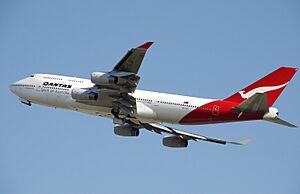
Qantas fully owns Jetstar, Jetconnect (which flies between Australia and New Zealand), QantasLink (for regional flights), and Qantas Freight (for cargo). Qantas used to own a small part of Air New Zealand but sold it in 2007. Qantas also owns 46% of Fiji Airways.
Qantas has been expanding Jetstar, launching international flights to holiday spots like Bali, Ho Chi Minh City, Osaka, and Honolulu since November 2006. Jetstar's lower costs allow Qantas to fly to places that might not have been profitable before.
The Boeing 747, which was once Qantas's only plane type, is now being retired. The last 747-300s were retired in 2008, and the 747-400s have been slowly replaced by the Airbus A380 and Boeing 787-9 Dreamliner since 2012.

On July 1, 2008, Qantas became a major owner of the Jetset Travelworld Group (now called Helloworld Travel). This created a travel company that handles retail, wholesale, and corporate travel.
Also in 2008, the first Qantas Airbus A380 was delivered on September 19. The plane arrived in Australia on September 21 at Sydney Airport. Qantas's first route for the A380 was from Melbourne to Los Angeles, starting on October 20, 2008.
In December 2008, British Airways and Qantas talked about possibly merging, which would have created the world's largest airline. However, they stopped discussions later that month.
On December 29, 2008, Qantas flew its last scheduled Boeing 747-300 flight. The last 747-300 was flown to the United States for storage on January 20, 2009. This also marked the last time a Qantas plane flew with a flight engineer.
After the Global Financial Crisis, Qantas decided to remove some first-class seats on shorter international flights to earn more money. Qantas said passengers would only be able to fly first class between Australia and London (via Singapore), and between Australia and Los Angeles.
In November 2012, Qantas took full ownership of Australian airExpress, a cargo company.
In April 2013, Qantas showed off new uniforms for its staff, designed by Martin Grant. The uniforms use navy blue, red, and fuchsia pink. Qantas CEO Alan Joyce said the new design "speaks of Australian style on the global stage."
In July 2013, Qantas announced it would increase fuel charges on international flights and raise domestic ticket prices due to a low Australian dollar and rising fuel costs.
On March 24, 2018, a Boeing 787 flew the first ever regular non-stop commercial flight between Australia and Europe. Flight QF9 was a 17-hour, 14,498 km (9,009-mile) journey from Perth to London Heathrow. In 2019, Qantas launched 19-hour flights on a restricted payload between New York and London to Sydney with 787-9s. In April 2018, Qantas sold its Q Catering division. In February 2019, Qantas bought a 20% share in Alliance Airlines.
On February 4, 2021, Qantas announced a deal with Alliance Airlines to use their E190 aircraft. These planes would first be used between Adelaide, Darwin, and Alice Springs. Qantas has since increased its use of these planes.
On March 2, 2022, Qantas announced a big order with Airbus for new planes for its domestic flights, including 20 Airbus A321XLR and 20 Airbus A220-300 aircraft.
On the same day, Qantas also ordered 12 Airbus A350-1000 planes for "Project Sunrise" flights. These planes will allow Qantas to fly non-stop from Australia's east coast to any other major city in the world, including New York and London. These planes will have fewer seats (238) than other planes of their size, with 40% of seats being premium.
On August 24, 2023, Qantas announced another order for international planes for "Project Fysh," including four 787-9s, eight 787-10s, and another 12 Airbus A350-1000s. These planes will replace the Airbus A330 and A380 in the Qantas fleet starting from 2027.
In June 2024, Qantas took full ownership of TripADeal, a travel company, after buying a 51% share in 2022.
Livery and Logos
The Qantas kangaroo logo first appeared in 1944. It was painted on a Liberator plane to celebrate the new "Kangaroo Service" route. The design came from the back of an old Australian one-penny coin. Since then, the kangaroo logo has changed four times. In 1947, Gert Sellheim added wings to the kangaroo to show it was flying. In 1954, it was painted on the tail of the Lockheed Super Constellations. These planes were mostly white with a red stripe.
-
A Boeing 707 with the "Red Stripe" design, used from 1959–1961.
-
A Boeing 747 with the "Flying Kangaroo" design, used from 1971–1984.
In 1959, Qantas was the first airline outside the United States to fly the Boeing 707 jetliner. The first 707 planes had a 'Red Stripe' design with a red "flying kangaroo" logo on the white tail. Qantas later bought the 707-138B planes with turbofan engines in 1961. These were painted with a 'V-Jet' design, with red tails marked "V-Jet."
To celebrate the arrival of the new 747 in 1971, the Flying Kangaroo logo became the main feature on the tail, and the stripe color changed to ochre.
-
A Boeing 767 with the "Roo" design and "Spirit of Australia" slogan, used from 1984–2007.
-
An Airbus A380 with the "New 'Roo" design, used from 2007–2016.
-
A Boeing 787 with the "Silver 'Roo" design, used from 2016–present.
The design was updated again in 1984 before Qantas started using the Boeing 767 in 1985. In this 1984 design, the Flying Kangaroo on the tail lost its wings, and the colored stripe was removed. The tail color now extended onto the plane's body, and a thin gold band was added. The slogan "Spirit of Australia" was also added to the planes.
The next big change happened in 2007, with the 'New Roo' design. This made the Flying Kangaroo look "polished" and "contoured." The changes were also made to fit the new Airbus A380 planes. Qantas said the new kangaroo was "sleeker and more contoured" and a "modern take" on the classic design.
In 2016, a new design with an updated kangaroo logo and special writing was shown on an Airbus A330-300. This was in preparation for the first Boeing 787 Dreamliner for Qantas. A silver band was added to make it look more fancy, and the writing was "streamlined." The Qantas name was also added to the bottom of the plane so people could see it from the ground. The Flying Kangaroo was made simpler, losing its arms and having a more abstract look.


